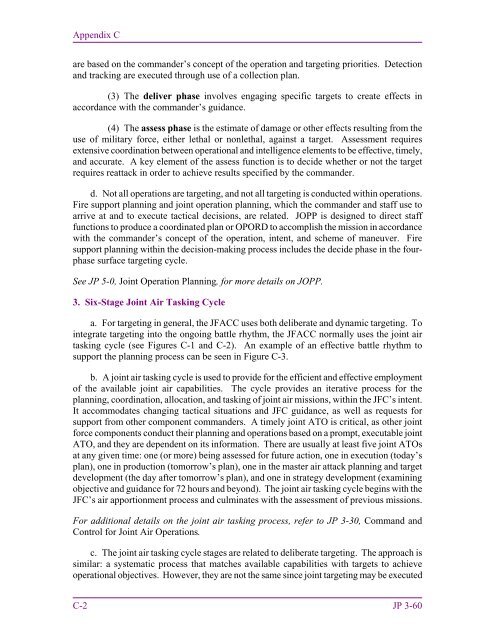Joint Targeting
1F87id9
1F87id9
Create successful ePaper yourself
Turn your PDF publications into a flip-book with our unique Google optimized e-Paper software.
Appendix C<br />
are based on the commander’s concept of the operation and targeting priorities. Detection<br />
and tracking are executed through use of a collection plan.<br />
(3) The deliver phase involves engaging specific targets to create effects in<br />
accordance with the commander’s guidance.<br />
(4) The assess phase is the estimate of damage or other effects resulting from the<br />
use of military force, either lethal or nonlethal, against a target. Assessment requires<br />
extensive coordination between operational and intelligence elements to be effective, timely,<br />
and accurate. A key element of the assess function is to decide whether or not the target<br />
requires reattack in order to achieve results specified by the commander.<br />
d. Not all operations are targeting, and not all targeting is conducted within operations.<br />
Fire support planning and joint operation planning, which the commander and staff use to<br />
arrive at and to execute tactical decisions, are related. JOPP is designed to direct staff<br />
functions to produce a coordinated plan or OPORD to accomplish the mission in accordance<br />
with the commander’s concept of the operation, intent, and scheme of maneuver. Fire<br />
support planning within the decision-making process includes the decide phase in the fourphase<br />
surface targeting cycle.<br />
See JP 5-0, <strong>Joint</strong> Operation Planning, for more details on JOPP.<br />
3. Six-Stage <strong>Joint</strong> Air Tasking Cycle<br />
a. For targeting in general, the JFACC uses both deliberate and dynamic targeting. To<br />
integrate targeting into the ongoing battle rhythm, the JFACC normally uses the joint air<br />
tasking cycle (see Figures C-1 and C-2). An example of an effective battle rhythm to<br />
support the planning process can be seen in Figure C-3.<br />
b. A joint air tasking cycle is used to provide for the efficient and effective employment<br />
of the available joint air capabilities. The cycle provides an iterative process for the<br />
planning, coordination, allocation, and tasking of joint air missions, within the JFC’s intent.<br />
It accommodates changing tactical situations and JFC guidance, as well as requests for<br />
support from other component commanders. A timely joint ATO is critical, as other joint<br />
force components conduct their planning and operations based on a prompt, executable joint<br />
ATO, and they are dependent on its information. There are usually at least five joint ATOs<br />
at any given time: one (or more) being assessed for future action, one in execution (today’s<br />
plan), one in production (tomorrow’s plan), one in the master air attack planning and target<br />
development (the day after tomorrow’s plan), and one in strategy development (examining<br />
objective and guidance for 72 hours and beyond). The joint air tasking cycle begins with the<br />
JFC’s air apportionment process and culminates with the assessment of previous missions.<br />
For additional details on the joint air tasking process, refer to JP 3-30, Command and<br />
Control for <strong>Joint</strong> Air Operations.<br />
c. The joint air tasking cycle stages are related to deliberate targeting. The approach is<br />
similar: a systematic process that matches available capabilities with targets to achieve<br />
operational objectives. However, they are not the same since joint targeting may be executed<br />
C-2 JP 3-60


